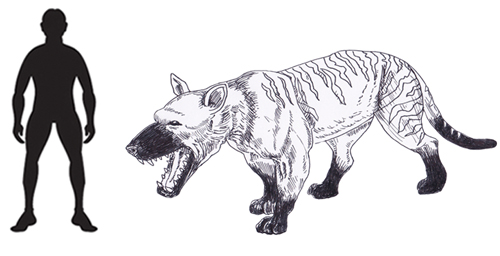Mojo Fun Prehistoric Mammals
The excellent “Prehistoric & Extinct” model range (Mojo Fun), contains a lot of dinosaur figures but today, we focus on a couple of prehistoric mammal models. We have praised this model range before, congratulating the company for producing figures of recently extinct creatures such as the Quagga of southern Africa and the Tasmanian Tiger (Thylacine). The range includes a number of other prehistoric mammals, replicas of some creatures that became extinct millions of years ago and not just within the last 150 years or so as in the case of the Thylacine and the Quagga.
A Scene Featuring Mojo Fun Prehistoric Mammals
Picture credit: Mojo Fun
Hyaenodon gigas and Deinotherium
The picture (above), depicts the fearsome Hyaenodon gigas one of the largest members of the Hyaenodontidae family (foreground). Some fossil specimens indicate that this cursorial mammal could have weighed as much as 500 kilograms. The large, elephant-like animal in the background is a Deinotherium, a very popular Mojo Fun prehistoric animal figure amongst collectors, after all, not that many replicas of “gigantic, terrible beast” have been produced.
The Mojo Fun Deinotherium Model

Wide Temporal and Geographical Ranges
Mojo Fun have taken great care in the creation of their promotional image. A spokesperson from Everything Dinosaur commented:
“It is always a pleasure to post up images depicting prehistoric animal models from the various ranges that we support. We have some more images kindly supplied by Mojo Fun of some of their new for 2019 prehistoric animals, we are looking forward to posting up these images to, when the figures come into stock.”
A Hyaenodon gigas Scale Drawing Based on the Mojo Fun Hyaenodon Figure
Picture credit: Everything Dinosaur
Fossils of both Hyaenodon and Deinotherium genera have a wide geographical and temporal distribution. H. gigas is known from the Lower Oligocene of south-eastern Mongolia, so it lived long before the first members of the Deinotheriidae evolved and certainly before the first members of this elephant family left Africa and became more widespread. However, as the Deinotherium genus is believed to have existed from the Miocene to the Pliocene Epoch and as some hyaenodonts persisted until the Late Miocene, it is possible that species of Deinotherium would have been contemporaneous with some of the last members of the Hyaenodontidae.
An interaction between a member of the Deinotheriidae and a carnivorous hyaenodont could have taken place.
To view the range of Mojo Fun models stocked by Everything Dinosaur: Mojo Prehistoric and Extinct Animal Models.








Leave A Comment